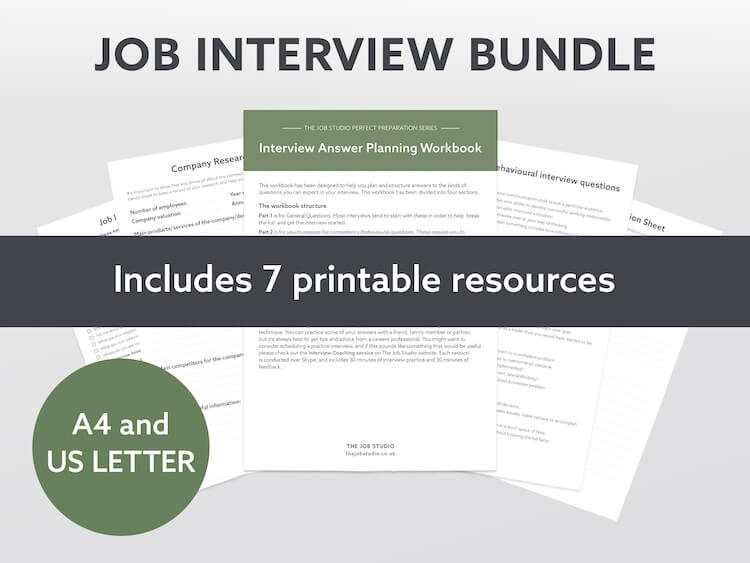
Employers don’t just use interviews to help them decide who’s the best person for the job; many will also ask candidates to deliver a presentation in an interview. As someone who's given their fair share of presentations over the years, I know how stressful preparing for both a presentation and interview can be, but there are some tried and tested things you can do to reduce the worry and boost your performance on the day. In this post I'll share how to plan a presentation for an interview from start to finish!
How to plan a great interview presentation
1. Read the brief carefully
Have you ever answered an exam question, only to realise you answered what you thought the question was asking, and not what it actually was? Before you rush into it, read the presentation brief again. What does the employer want you to do in the interview presentation? If the brief includes a phrase, concept or word you’re unfamiliar with, look it up. It’s essential you’re clear on the brief before moving on to the next step.
2. Brainstorm your ideas
Once you’re clear on the brief you need to start brainstorming your ideas for the presentation’s content. Don’t over-think this, just get all your ideas down. I find mind-mapping really useful, but you could use post-it notes or make a list of relevant things – whatever works for you. You can also run your ideas past a friend or family member, as they may have different perspectives or ideas you’ve not considered which will enhance your presentation.
3. Start researching
It’s now time to start researching in more depth. Not all topics or questions will require the same level of research, but it can often be helpful to put in a few solid hours to get to grips with the subject area. Google searches and online resources are a good place to start, but remember you have social media and the library too. Spending the time to research the topic can really help you plan a great interview presentation, so don't overlook this step.
4. Identify your main points
A key part of knowing how toprepare a presentation for an interview is to identify key themes or topics to cover in your presentation. These are the main arguments or points you want to make which will help you plan a great interview presentation. Be mindful of how much time you have to deliver the presentation – this will help you avoid spreading yourself too thinly or struggling to fill time.
Turn interview stress into success

5. Decide on your structure
Now it’s time to decide on the all-important structure of your presentation. This is probably one of the most important steps when deciding how toprepare a presentation for an interview. Yours will depend on the topic or question provided to you in the brief, but here are a few examples of how you could structure your presentation: before, during and after – past, present, future – client, problem, solution. Another good technique is to group your points into themes. You will notice the examples I’ve provided are divided into three parts, and this is because splitting your argument or explanation into three segments is a well-established technique for getting your points across more effectively. I always use this technique in my presentations and advise my clients the same when they want to know how to prepare an interview presentation - it never fails.
6. Start writing your first draft
Once you’ve identified a structure, you need to start getting pen to paper and write a first draft of your presentation. Don’t worry about how it sounds at this stage, just write! A lot of people worry about what to say in the introduction or conclusion but leave this for now, it will be much easier to write once you have a clearer idea of your main content.
7. Write an opening and an ending
A key part of knowing how to plan a great interview presentation is to understand the importance of a strong start and finish. There's nothing worse than a long introduction, so keep yours concise so you can get into your main points. There are various ways you can introduce your presentation – asking a question, showing an image or simply stating ‘In this 10-minute presentation I will...’ It’s a good idea to briefly explain what you are going to cover, as this will make sure your audience knows what to expect.
Your conclusion needs to tie together all the points you plan to make into a short ‘answer’ or message to your interview panel. This doesn’t have to be called a conclusion, it could be a ‘Summary’ or ‘Final thoughts’ section. The conclusion should be a similar length to your opening. If you have 10 minutes, it’s a good idea to allocate no more than 1 minute each to your introduction and conclusion.
8. Create PowerPoint slides
Want to know how to plan a great interview presentation that engages your audience? Use visuals! Of course you don’t have to use visuals in your presentation, but they can bring your presentation to life and make it more engaging. Before you create them, it’s a good idea to check with the employer you are interviewing with that they have the facilities you need. Make sure you save your PowerPoint file on two separate memory sticks in case one doesn’t work on the day.
9. Write index-cards
Unless the employer tells you otherwise, you may want to use index cards to act as prompts during the presentations, particularly if it’s 10 minutes or more in duration. I always use index cards - for me, it's not worth the risk of forgetting what I want to say in front of the interview panel. You don’t want to write a script on these, just the main points you want to cover. I find using bullet-points on each card effective, listing a few words or key phrases. If you forget your words, you only need to glance down to jog your memory.
10. Practice, practice, practice
Want to know my top tip for how to prepare for an interview presentation? If you want to give a polished presentation the only real way is to practice. You don’t want to learn your presentation off by heart, but you want to be confident in what you’re saying. This takes time and lots of practice, so ensure you put the time in before the interview to do this – it will really pay off. I usually advise my clients finalise their presentation no less than 24 hours before their interview, but the more time you have to practice, the better.
So there you have it, 10 steps for how to plan a great interview presentation. Did you know I can help you create engaging PowerPoint slides for your interview presentation? Get in touch today to find out more.

